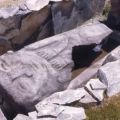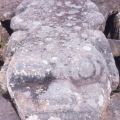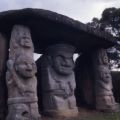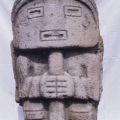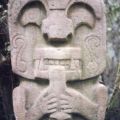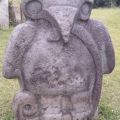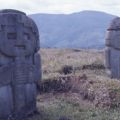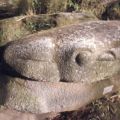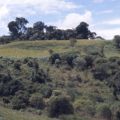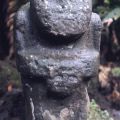Some Peek in the Stacks blog posts are authored by CSUN students who work in Special Collections & Archives. This week's post was written by Heather Seiden. Heather is a second-year graduate student in the Anthropology program specializing in archaeological research and education.
Photography's place in archaeology is often overlooked. Yet, the ability to freeze a moment in time makes photography an invaluable tool in the field and is central to archaeological methods and analyses. 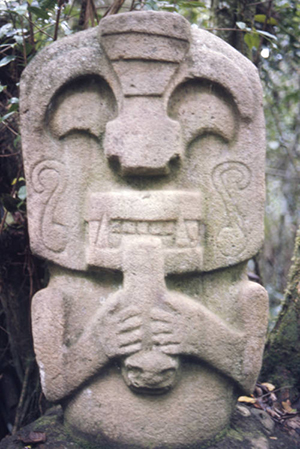 The Richard Cross digital collection at the Tom & Ethel Bradley Center provides a perfect example of the link between photography and archaeology. Richard Cross's photographs demonstrate his extraordinary ability to document groups of people who have often been marginalized and ignored. Among his most notable projects are his images of Afro-Colombians in Palenque de San Basilio, Colombia, the wars in Nicaragua, Honduras, Guatemala, and El Salvador, and his graduate work with the Ilparayuko Massai in Tanzania for an ethnographic film project.
The Richard Cross digital collection at the Tom & Ethel Bradley Center provides a perfect example of the link between photography and archaeology. Richard Cross's photographs demonstrate his extraordinary ability to document groups of people who have often been marginalized and ignored. Among his most notable projects are his images of Afro-Colombians in Palenque de San Basilio, Colombia, the wars in Nicaragua, Honduras, Guatemala, and El Salvador, and his graduate work with the Ilparayuko Massai in Tanzania for an ethnographic film project.
However, some of his work before these ethnographic projects involved documenting archaeological sites in Colombia. After resigning from his position as a journalist in Minnesota, Cross embarked on a four-year assignment with the Peace Corps, relocating to Bogotá, Colombia, from 1974 to 1978. In Colombia, Cross worked as an audio-visual consultant for government agencies, including the National Institute of Renewable Natural Resources and Environment (INDERENA), the Coffee Growers Association, and the Colombian Institute of Culture, documenting archaeological sites. The Institute of Culture, established in 1968, aimed to promote, preserve, and encourage Colombian archaeological, artistic, and historical culture and foster scientific research, libraries, museums, and cultural centers. It is also through this assignment that Cross met Nina Friedemann, the Colombian anthropologist whom he would collaborate with on the project in Palenque.
One of the sites that Richard Cross documented for the Colombian Institute of Culture is San Agustín Archaeological Park, considered the most expansive necropolis in South America. San Agustín is located on the upper banks of the Magdalena River in northwest Colombia, where 300 megalithic sculptures and funerary monuments adorn the landscape. Archaeologists and anthropologists have studied these elaborate pre-Columbian relics since their rediscovery in the 18th and 19th centuries. Nearly 2,000 years ago, specialized artisans carved these megalithic sculptures from tuff and volcanic rock and painted them with bright colors like yellow, red, and white. Although few still retain their decorative pigments, they remain as protectors over the tombs beneath.
Between the 1st and 8th millennium, the San Agustín people constructed tombs made from large stone slabs for elite individuals before covering them with large earthen mounds and positioning the megalithic sculptures on top. The sculptures range from eight inches to twenty-three feet tall, depicting diverse elaborate forms, including jaguars, snakes, frogs, and birds, as well as humans, supernatural forms, and deities sharing human and feline features. Archaeologists assert that the emergence of these sculptures in the 1st millennium BCE points to social and ideological transformations that caused a shift in funerary traditions for the San Agustin culture. The scale of these impressive sculptures and elaborate tombs reflects a growing complexity within this society but also points to social stratification.
 In archaeological research, there is a tendency to focus on influential individuals who maintained power and wealth. However, Cross' photographs of San Agustín highlight the work of the individuals in this community that may have been marginalized or ignored. The labor, skill, and cooperation required to construct such exceptional megalithic structures and funerary monuments are almost unimaginable. Yet, through these photographs, their skilled work comes to life nearly 2,000 years after they were built. Ultimately, these photographs of San Agustín reflect the same mastery that Richard Cross possessed for photographing people who are often "invisible" and shining a spotlight on their lives. They demonstrate how photography can be an invaluable tool in archaeology by freezing a moment in time and telling the story of people who are too often omitted from history.
In archaeological research, there is a tendency to focus on influential individuals who maintained power and wealth. However, Cross' photographs of San Agustín highlight the work of the individuals in this community that may have been marginalized or ignored. The labor, skill, and cooperation required to construct such exceptional megalithic structures and funerary monuments are almost unimaginable. Yet, through these photographs, their skilled work comes to life nearly 2,000 years after they were built. Ultimately, these photographs of San Agustín reflect the same mastery that Richard Cross possessed for photographing people who are often "invisible" and shining a spotlight on their lives. They demonstrate how photography can be an invaluable tool in archaeology by freezing a moment in time and telling the story of people who are too often omitted from history.




